 |
| Parade of Decorated Balsas |
I, together with other members of the print and broadcast media, were again invited (my first was a media familiarization tour last March 23 and 24) to cover the First Balsa Festival in Matabungakay, Lian. Matabungkay’s very shallow beach is lined with about 150 of these rented balsas, all ingeniously fitted with shaded picnic tables and grills for visitors who want to go dining al fresco, swimming, snorkeling, sunbathing and, at the day’s end, watching the magnificent sunset. These hardy balsas and their navigators have, in effect, become the durable and unique symbol of Matabungkay and a very important contributor to Lian’s tourism livelihood economy.
 |
| Sunset at Matabungkay |
We were guests of the 4.2-hectare, DOT-accredited “Class AA” Matabungkay Beach Resort and Hotel (MBRH). Just recently, the resort was named as the “Most Outstanding Beach Resort of 2002” during the 17th Annual Parangal ng Bayan Awards and the 2002 National Consumer Excellence Awards. As festival hosts, MBRH was in the thick of preparations with the visibly-tired Ms. Charley Leviste-Antonio (Vice-President for Operations), Ms. Marissa Romero-Balangue (Marketing and Sales Director), Mr. Rico M. Violeta (General Manager) and Ms. Blessie Zarzuela (Gen. Manager of Adea Advertising) ably providing the push.
We arrived at Matabungkay in time for the festival’s highlights: the Balsa Race and the Parade of Decorated Balsas. The weather was perfect with the sun shining brightly on a cloudless, blue sky. The race and parade was held along the beachfront of Kandahar Resort. Invited guests of honor included Sen. Loren Legarda-Leviste and former Batangas Gov. Antonio Leviste. The Balsa Race was a test of the boatmen’s strength, endurance and dexterity with the bamboo pole as they navigated their sometimes unwieldy balsas to the end of a one hundred meter long course along the shoreline. The winners took home cash prizes of PhP10,000, PhP7,000 and PhP5,000 for first, second and third place respectively.
 |
| Matabungkay’s hardy balsas |
The Parade of Decorated Balsas was truly a spectacle in itself. It also had a message: recycling and use of indigenous materials. This theme was evident among the eleven entries who vied for even bigger cash prizes of PhP20,000, PhP15,000 and PhP10,000 for first, second and third respectively. Aside from bamboo, the indigenous material from which all balsas are made, the entries also made free use of the town’s famous caballero flowers, the fiery-red blooms of the flame tree. Recyclable materials of choice were old newspapers (as banderitas) and plastic, colored water-filled, 1.5-liter soft drink bottles strung together. The star of the parade (although not the winner) and the photographer’s delight was a balsa featuring a gay, blue-painted shokoy (local name for a “merman”).
 |
| A crowd favorite |
After the show, it was back to MBRH for a sumptuous, a la carte lunch at its Caballero Café. Later, we were all booked in some of the resort’s 57 airconditioned superior and executive guest rooms with cable TV, private bath and spacious veranda. In the afternoon, the mood of the Balsa Festival turned Filipiniana as MBRH also played host to two exciting games, both qualifying as the Filipinos’ version of “Grease.” The first was a palo sebo, where contestants had to clamber up a greased up bamboo pole in a no-holds-barred race to grab the pennant on top. Equally greasy was the habulan ng biik, where contestants raced against each other in a bid to be the first to catch a greased up piglet. Poor pig.
 |
| A senior citizen dance |
Later in the afternoon, students from the town’s different secondary and tertiary schools as well as senior citizens showcased their talents in dance and other production numbers at MBRH’s basketball court. Quite a colorful sight was the dance troupe which performed a komedya (also called a moro-moro), an age-old dramatization of the battle between Christians and Moors. It won the top prize. Another sure-fire scene stealer was the town’s old ladies in white and multi-colored balintawak attire who showed a lot of spunk in rendering a native dance. One even regaled the appreciative crowd with her whole-hearted rendition of the timeless song “Tayo na sa Antipolo.” Bravo! Come nighttime, the festival was capped by band performances where the townspeople slowly but surely danced the night away, to the beat of old and new disco tunes, up to the wee hours of the morning. What a way to end a day (and a festival).











